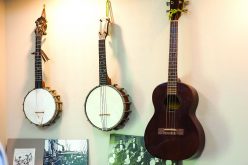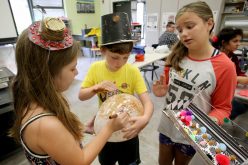‘Boonsboro’ rural pottery on display in Cane Hill
LYNN KUTTER
lkutter@nwadg.com
For Lawrence McElroy, director of arts and culture for Historic Cane Hill, a new public exhibit on rural potters is a way to bring many pieces of 19th century stoneware back home.
The exhibition, titled “Men of Earth: Nineteenth Century Potters of Northwest Arkansas,” focuses on J.D. Wilbur, a master potter who arrived in Boonsboro (now Cane Hill) from Ohio around 1868.
Wilbur came from a family of 27 potters, including his father and brothers, but McElroy has yet to find out what drew him to this area from Ohio.
That’s just one of McElroy’s questions about Wilbur. The bigger question, he says, is how did Wilbur know Boonsboro had the proper clay for making pottery?
The pottery exhibit at The Museum Gallery at Historic Cane Hill will feature 19th century salt-glazed stoneware that includes many pieces that have never been seen by the public, narrating the life and work of 15 rural potters who once called Northwest Arkansas home.
The “Men of Earth” exhibition opened in conjunction with the Cane Hill Harvest Festival last weekend and will run through Nov. 24. The gallery hours are 10 a.m. to 5 p.m. Wednesday-Saturday and by appointment.
McElroy’s interest in Cane Hill pottery started when he came to the community as curator for Historic Cane Hill Museum. He found a small collection of seven pieces of pottery made by Wilbur. McElroy says he wanted to highlight the pieces but realized the collection was really too small for an exhibit. But Historic Cane Hill plans to open a pottery studio in the future, and discussions about that reignited McElroy’s interest in Wilbur’s collection.
McElroy says he incorrectly assumed Wilbur was an itinerant person passing through Cane Hill until he started researching the man. His research found evidence of a “much, much bigger story.”
For one, he learned about Wilbur’s family of potters. He learned that Wilbur built his own kiln from scratch in Cane Hill. McElroy also began to learn about other potters in Northwest Arkansas from 1845 through the early 1890s. From his research, he says he was able to link Wilbur in Cane Hill to other major pottery centers in Benton, Texarkana, Ohio and Texas.
“It’s a fascinating network of potters,” McElroy says, comparing his research to detective work. “Completely unexpected things keep popping up.”
Once he saw connections and links between some of the potters, McElroy says he started looking for those within every story.
“It’s a crazy network that I did not anticipate at all.”
The exhibition will have about 40 pieces of pottery, along with 25 graphic panels with photographs, text and other information. It includes a 500-year-old Native American vessel recovered from an Ozark bluff shelter in this area and looks forward to the art pottery movement in America in the early 20th century.
Prominently on display will be Wilbur’s utilitarian stoneware pottery, used for everyday life, including churns, storage jars, pitchers, crocks, jugs and some flower pots.
“It will be the largest collection of Boonsboro pottery every amassed at one place in one time,” McElroy says.










